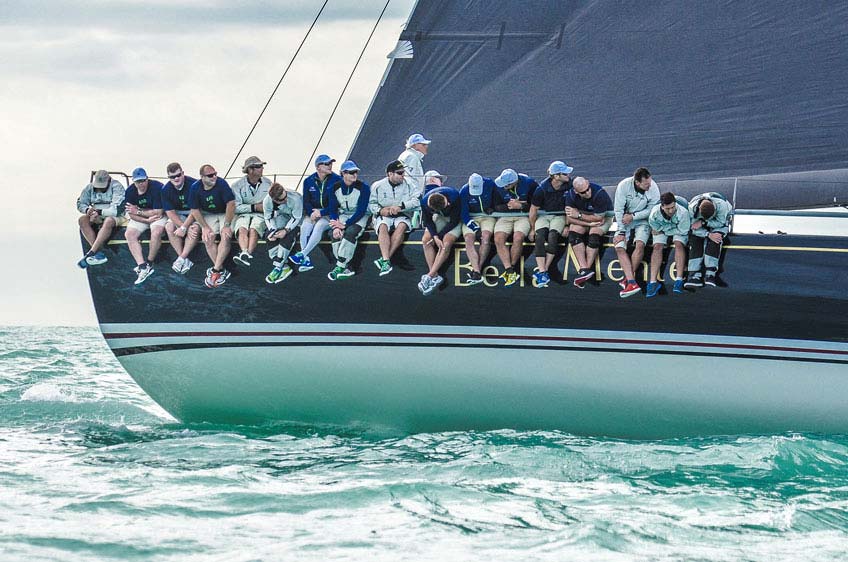Weighting is key in sailing performance, whether you're neck-and-neck while racing or reaching across a bay on a beautiful day with your family. Quantum's Jay Sharkey gives his pro tips on making the best of the weight onboard whenever you’re on the water.

One of the biggest benefits of modern sailmaking technology is that it has allowed sailmakers to decrease weight aloft through the application of lighter and stronger materials. Racer or cruiser, anyone who has made the switch from traditional cross-cut Dacron sails to an iQ Technology® membrane variety can attest to the significant performance increase due to less heeling and superior shape-holding characteristics.
But reducing weight aloft is only one way that you can improve performance. Properly utilizing the weight on-board can also yield big benefits and is key to optimizing your speed and efficiency through the water. This is obvious for racers as the lighter you can get, the better you’ll do. For cruisers it might not sound as important, but when you’re sun fried, ready be home and the wind dies a few miles from your slip, you’ll be happy you took this advice.
Think Light:
Before a regatta or heading out for a day cruise, have a look at the forecast to see what conditions are expected and pack your gear bag accordingly. If the weather service is predicting light breeze and warm conditions, keep your heavy offshore kit at home and bring only what you think you’ll need for the day. It doesn’t have to be as extreme as cutting the handle off your toothbrush (ala the Volvo Race) but every pound counts so leave the extra gear on the dock when you can and pack smart.
On Board:
Anyone who has spent time on a thoroughbred race boat knows how bare-bones the accommodations are down below as a result of the incessant quest for lightness. Gear bags have their designated places and there are no added frills other than what’s necessary to get the boat around the course. Production racers and cruisers, on the other hand, tend to blur the line between comfort and function with galleys, enclosed heads, cabinets and drawers, all of which beg to be filled with stuff you think you “might need.” Resist this urge as best you can and if you’re able to do so, keep the barbeque in the dock-box while you’re on the water. Once the boat is as light as you can get it, do your best to concentrate the remaining onboard weight as close to the center of the boat as possible and as low as you can get it. This will lower the center of gravity and reduce pitching moment by getting the weight out of the ends.
Use Your Crew and Guests:
Common sense dictates that when the boat is heeled over it’s time to put crew weight on the rail or have your guest move to the high side, but there’s more to positioning your crew weight than just hanging legs over the side. Keep in mind that the heel angle has an effect on the boat’s balance – heeling to leeward makes the boat want to head up while windward heel will have the opposite effect (especially valuable when trying to sail deep angles downwind). Upwind in light conditions, most boats perform best with a slight angle of heel so consider having people leeward and as close to the shroud base as possible. In extremely light air (and if you’re one design racing, make sure your class rules allow it) you may even want to consider the “dogs in the house” approach (having crewmembers or guest go below and if possible, to leeward, to lower the center of gravity) to keep the boat moving.
As the breeze increases, weight is moved from the leeward side to windward, always keeping the weight as close together as possible and checking the fore/aft trim of the boat by keeping an eye on the bow wave; if the bow is digging in, move a body aft until the knuckle of the bow comes up.
Crew and guest weight placement downwind also plays a major part in how the boat behaves. When it’s light, keep the people placed forward and as close to the shrouds as possible without having anyone forward of the mast. This will not only get the stern out of the water a bit but also give the helmsperson some feedback on the rudder as the boat will want to turn to windward with induced leeward heel. Once the breeze starts to rise, weight is moved aft and to windward to keep the boat flat and take advantage of the boat’s inherent form-stability. Once the wind is blowing hard it will become necessary to stack as many people aft as possible to keep the bow up and to induce surfing or plaining if the conditions allow.
It’s amazing the difference a few tweaks can make for your race or your cruising efficiency. Experiment with these tricks and practice traveling light.